 BUY IT AT AMAZON: CLICK HERE!
BUY IT AT AMAZON: CLICK HERE!
STUDIO: Warner Home Video
MSRP: $31.99
RATED: Not Rated
RUNNING TIME: 119 min.
SPECIAL FEATURES:
• Available Subtitles: English, Spanish, French
• Available Audio Tracks: English (Dolby Digital 2.0 Stereo), French (Dolby Digital 1.0)
• Disc One:
• Newly remastered and restored from original VistaVision film elements
• Introduction by Patrick Wayne
• Commentary by Peter Bogdanovich
• Theatrical Trailer
• Disc Two:
• "The Searchers: An Appreciation" featurette
• "A Turning of the Earth: John Ford, John Wayne and The Searchers" featurette
• Behind the Cameras: Meet Jeffrey Hunter, Monument Valley, Meet Natalie Wood, Setting Up Production
• Ultimate Collector’s Edition includes:
• Reproduction of 1956 Dell comic book
• Reproduction of original 1956 Warner Bros. press book
• Reproductions of filmmaker memos and correspondence
• 10 postcards with behind-the-scenes photos
• Movie poster offer
The Pitch
"It’s Taxi Driver, but with cowboys and Indians!"
The Humans
John Wayne, Jeffrey Hunter, Natalie Wood, Vera Miles, Harry Carey Jr, Ward Bond
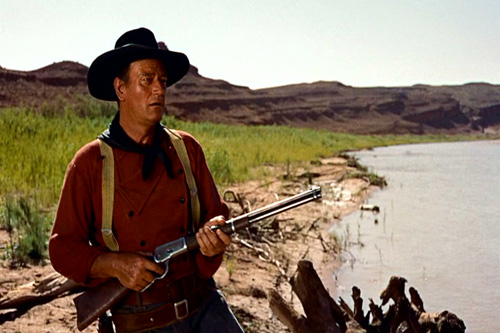
The Nutshell
Comanche Indians attack and massacre the inhabitants of the Edwards homestead, and their Chief, Scar, kidnaps a child named Debbie. Her uncle Ethan, a bigot and killer, and her adopted brother Martin, a half-breed, obsessively spend the next ten years searching for her. But does Ethan want to rescue her or kill her because the Comanche have had their way with her?
The Lowdown
Warner Bros’ John Ford/John Wayne box set has come just in time to complete the rehabilitation of John Wayne’s image, restoring him to the position in movie history he held before his politics overshadowed his work and his name became synonymous with violent, ugly Americans. In the next couple of days I’ll be reviewing the rest of the box set, which includes monumental classics like Fort Apache and Stagecoach, but there’s one film that deserves its own examination: The Searchers. Not only is the Ultimate Collectors Edition the cornerstone of this box set, The Searchers itself is in a way the cornerstone of modern filmmaking and is, arguably, the best film ever made.
In the 70s John Wayne was approached by a journalist who commended him on his role as a villain in The Searchers. The Duke angrily shot back that Ethan Edwards was no villain; in fact Wayne had one of his grandsons named in the character’s honor. And he wasn’t wrong – Ethan is not only not a villain, he’s one of the greatest cinema characters of all time, and it’s the complexity that makes him so great that also makes him ripe for misinterpretation.

It’s easy to see why that journalist saw Ethan Edwards as a villain. The character is a racist for sure, and he’s filled with a violent rage. At the beginning of the film he returns home to his brother’s Texas ranch three years after the Civil War, where he fought for the Confederacy, but Ethan doesn’t see the war as over; he never turned in his saber, and he can’t take an oath as a deputy because he still sees his oath to the Confederacy as binding. He shows up with hundreds of freshly minted Yankee dollars, too, acquired mysteriously.
There are other things that could lead the unobservant viewer to think that Ethan is a villain: he’s relentlessly cruel to his nephew, the quarter Indian Martin Pawley; he has no respect for faith and religion; he desecrates the corpse of an enemy, and most of all it becomes clear that his ten year search for young Debbie isn’t to rescue her from the Comanche who have kidnapped her, but to kill her.
But there’s more to Ethan than that, and it’s Wayne’s masterful performance that brings that out: an early, tender scene between Ethan and his brother’s wife, who he obviously loves; a quiet moment when he learns that a cattle rustling was a diversion for an attack on the homestead, and most of all when he’s telling Harry Carey Jr’s Brad that his fiancée Lucy has been killed by the Comanche. “What do you want me to do? Draw you a picture? Spell it out? Don’t ever ask me! Long as you live, don’t ever ask me more.” It’s a completely devastating moment.
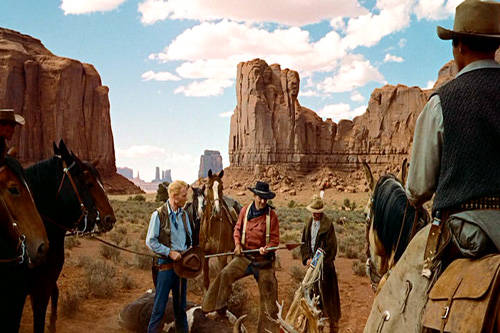
It’s also an example of the genius of director John Ford. The Searchers contains some of the most horrific images you’ll never see, like Lucy’s corpse. The dialogue hints enough that we know she was left naked, probably violated. We see the prelude to the Comanche raid on the Edwards homestead (a truly terrifying sequence, by the way, still packing a punch 50 years later. There’s a moment where young Lucy realizes what’s about to happen to the family and the camera rushes in at her as she screams that’s bloodcurdling) but not the actual attack. We don’t have to; Ford sets up the aftermath so well using nothing but a bloody dress to indicate the rape and murder of the women, and Wayne sells the carnage with dreadful gravity. That scene, by the way, was lifted by George Lucas for Luke’s discovery of his dead Aunt Beru and Uncle Ben in Star Wars; that version is a Xerox of a Xerox, a wan, lifeless take on the work of a real master.
The Searchers is set in Texas, but it’s shot in Monument Valley, a place that not only looks nothing like Texas but that looks nothing like anything except itself… and John Ford’s West. The ancient buttes and plateaus of Monument Valley are so associated with the career of Ford, who essentially discovered the area for the movies, that a popular lookout spot has been named John Ford’s Point. From the first shot of The Searchers, a bookend to the film’s justly famed final shot, it’s apparent that this is no Texas we’ve seen before, and it’s fitting, since The Searchers is really a film about America as a concept; this is the West of the imagination and the mind. And it’s never looked better – Ford shot in the Valley nine times, but it’s with the tremendous Vistavision lens that he gets the most out of it. Almost every location shot in The Searchers is breathtaking, and Ford frames every shot with the eye of a master painter. What’s most amazing about Ford’s gorgeous framing is that it never feels like he’s doing showy shots – the action and story never suffers. He just seems to instinctually be able to place his camera in the exact right place to capture the action, the characters, and the unbelievably grandiose beauty of Monument Valley.
It’s the film’s thematic elements that help catapult it from great to the greatest. The Searchers is filled with tremendous performances (especially Jeffrey Hunter as Martin. Hunter would go on to star in the pilot of Star Trek), beautiful vistas, stirring action scenes and a terrific story, but it’s the theme and subtext that make each viewing of something new. Ford uses The SearchersThe Searchers to meditate on everything from race relations to the nature of violence and vengeance. The movie was released in the middle of the Montgomery Bus Boycott, sparked by Rosa Parks’ refusal to give up her bus seat and which would in turn be one of the defining early moments of the Civil Rights Movement. The film was made before that flashpoint, but Ford was obviously aware of the gathering racial stormclouds; there’s no way to read Ethan’s homicidal hatred of miscegenation as anything but an examination of current events.
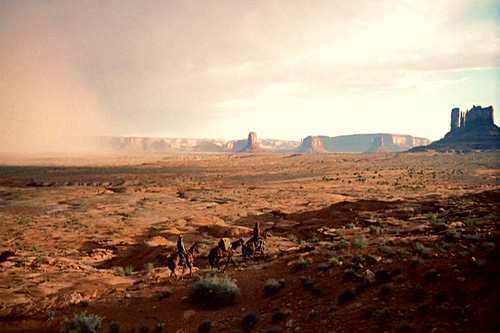
What’s interesting is how the Martin Pawley character works in this scenario. The Searchers is adapted from a book, and one of the many changes made to the story was to have Martin be part Indian. He is the product of the very miscegenation that Ethan sets out to destroy and yet he’s the older man’s constant companion for a decade. In fact we’re told it was Ethan who rescued Martin as a baby. Martin’s racial background places him in strange positions – at one point his fiancée, sick of waiting for the two men to finally come home so she can be married, tells Martin that Debbie’s mother (Martin’s adopted mother) would rather her daughter die than “be with” the Comanche. “Fetch what home?… The leavin’s of Comanche bucks — sold time an’ again to the highest bidder?… With savage brats of her own, most like?…” she says.
Martin doesn’t fare much better with “his own people.” Indians don’t get much comparative screen time in The Searchers, but one subplot is very interesting. While trading for supplies, Martin accidentally acquires himself a roly-poly Indian wife. The sequence is played for laughs and feels strangely cruel and misogynistic. It’s only later that we understand where Ford’s going with this – Martin gets rid of the wife and later comes upon her village, which has been massacred by the US Cavalry. It’s a troubling scene, one that resonates fifty years later with revelations about the massacre in Haditha. Many of John Ford’s Westerns are about the costs of nation building, and because of that they’re very relevant today as we relive Cavalry and Indian scenarios in Iraq. And sadly still relevant are the film’s musings on the nature of violence – Chief Scar, the evil kidnapper, talks about how his sons were killed by whites and how he has taken many white scalps in retaliation. The Cavalry takes their revenge on that village, and then the Indians will eventually return the violence.
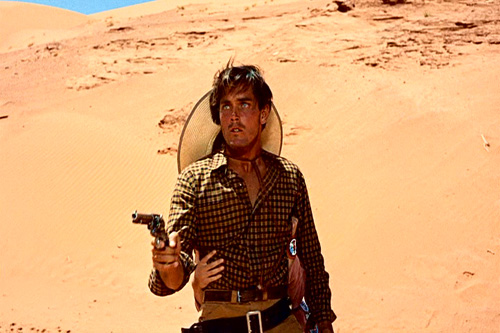
At the end Ford shows a severing of the violence – Ethan’s hand is kept from killing Debbie first by Martin, and then eventually by his own choice. Over the course of their obsessive quest Martin has grown to be a man, thanks to Ethan, and Ethan has learned something from Martin as well. As the movie closes out on the iconic image of Ethan being shut out of the house, left to wander alone, it becomes obvious that he’s the past which must be discarded. Multiracial Martin is the future, and his influence kept Debbie alive. Martin could never have found Debbie without Ethan, but Ethan could never have found his own soul without Martin. But even though he is somewhat redeemed, Ethan has no place in the future Martin is building.
There’s more to talk about, from the powerful zoom on Ethan’s face after he sees the white women who have been driven insane by Indian rape (a zoom that in some ways recalls the epic pull in that announced Wayne in Stagecoach, not the first film he did with Ford but certainly the first one that cemented their collaboration as a great one) to the treacherous Futterman to the shootout at the river to wise fool Mose Harper… The Searchers is the rare movie that deserves books to be written about it. It’s as rich and deep as any movie ever made, and five decades later it still feels fresh and modern.

The Package
If you’re going to buy The Searchers on DVD – and honestly, any DVD collection without this film in it is woefully incomplete – the Ultimate Collectors Edition is the way to go. This two disc set is gorgeous, and it comes with some excellent ephemera that you can enjoy on your fifth or sixth spinning of the disc in a week.
The transfer of the film is fairly spectacular. The Vistavision process was a huge widescreen process, and most prints of The Searchers had to be shrunk down to 35mm in its initial run because it was a rare theater that could accommodate Vistavision. That said, Vistavision offered an unparalleled clarity and depth of vision – there are scenes with characters talking in the foreground while the buttes in the background are sharply clear and in focus – you can pick out what seems like every crag and nook.
Disc one has a commentary by Peter Bogdanovich, who knew Ford late in his life. It’s a decent enough commentary, but not great. I would rather have had Warners recreate the essence of their excellent Peckinpah DVDs, where they gathered a number of biographers in a recording studio. Those commentaries are packed with information; Bog’s track is mildly diverting and his voice may make you very sleepy. The sound quality is fine – the film was released in mono, and that was what the previous DVD release had. This one is stereo; nothing too fancy. There’s also an original trailer on the first disc.
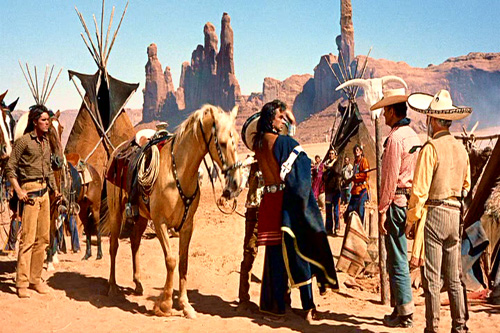
Disc two has some excellent features. Best of all is The Searchers: An Appreciation, which has Martin Scorsese, John Milius and Curtis Hanson (?!) talking about the film. Film criticism lost one of the greats when Scorsese went into directing – scratch my earlier commentary suggestion and have Scorsese record commentary for every great film. Milius is strong as well, while Hanson seems a little out of place. This thirty minute feature is all-around fantastic, though, and just about makes double dipping on this film worth it all on its own.
Also good, but much less so, is A Turning of the Earth: John Ford, John Wayne and The Searchers, featuring voice overs by surviving actors from the film and John Wayne’s son Patrick. The doc is weirdly structured, or rather barely structured. It has the general coherence of someone telling a story and going off on tangents. It’s not bad, but much of the information has been delivered, and better, in An Appreciation.
Finally there’s Behind the Camera, 20 minutes of 1956 vintage Warner Bros propaganda material. This stuff ran as part of a Warners TV show back in the day, and there’s some interesting behind the scenes material, especially the segment about the tent city that had to be created – Monument Valley’s sole motel couldn’t hold the whole cast and crew.
The Ultimate Collectors edition contains some fun goodies, best of which is a reproduction of the original Dell Comics adaptation. It’s fascinating to read this miniaturized comic and see what got sanitized for the kiddie audience. The psychologically epic finale winds up on the back cover. Also included are a reproduction of the advertising book (you will now know every variety of signage for The Searchers ever), ten candid behind the scenes photos and reproductions of some mildly interesting if weirdly uninformative memos from the film’s pre-release.
